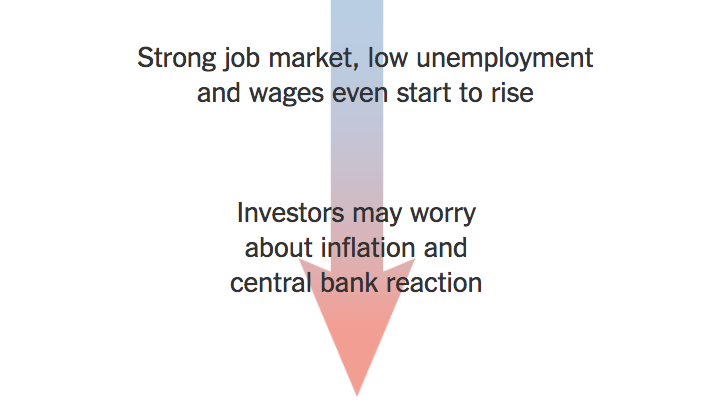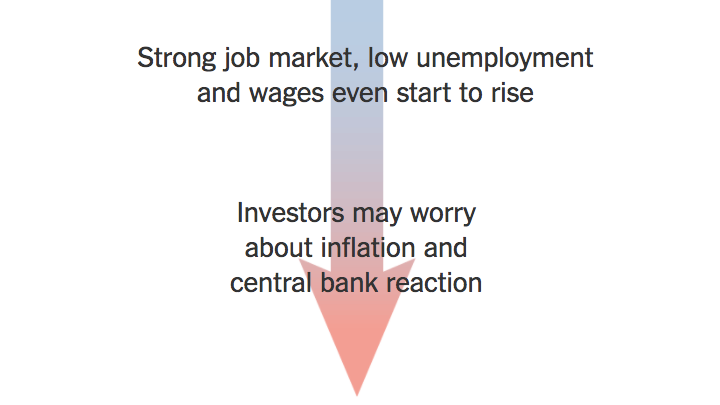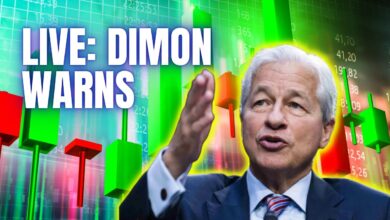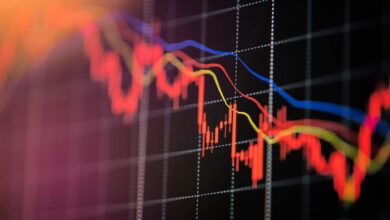
The Stock Market is Not the Economy: Understanding the Difference
The stock market is not the economy, despite what many headlines might suggest. While they are interconnected, the stock market is a reflection of investor sentiment and future expectations, not a direct measure of the overall health of the economy.
It’s a crucial distinction to understand, especially for those seeking to navigate the complexities of investing.
Think of it this way: the stock market is like a thermometer, measuring the temperature of investor confidence and future prospects. The economy, on the other hand, is the patient – a complex system with many moving parts, including employment, production, and consumer spending.
While the thermometer can offer insights, it’s not the whole picture.
The Stock Market as a Reflection of the Economy
The stock market is often seen as a barometer of the overall economy. While it’s not a perfect indicator, the performance of the stock market can provide valuable insights into the health of the economy and its future prospects. The intricate relationship between the stock market and the economy is driven by various factors, including economic indicators, investor sentiment, and market psychology.
The Influence of Economic Indicators
Economic indicators play a crucial role in shaping stock market performance. These indicators provide valuable information about the current state of the economy and its potential trajectory.
- Gross Domestic Product (GDP):GDP measures the total value of goods and services produced in a country. A strong GDP growth rate typically leads to increased corporate earnings and higher stock prices. Conversely, a decline in GDP growth can signal economic weakness and lead to a decline in stock prices.
- Inflation:Inflation refers to the rate at which prices for goods and services increase over time. High inflation can erode corporate profits and reduce investor confidence, leading to lower stock prices. However, moderate inflation is often considered healthy for the economy.
- Interest Rates:Interest rates are the cost of borrowing money. When interest rates rise, it becomes more expensive for companies to borrow money, which can negatively impact their earnings and stock prices. Conversely, lower interest rates can stimulate economic growth and lead to higher stock prices.
- Unemployment Rate:The unemployment rate measures the percentage of the workforce that is unemployed. A low unemployment rate indicates a strong economy and can lead to higher stock prices. Conversely, a high unemployment rate can signal economic weakness and lead to a decline in stock prices.
Investor Sentiment and Market Psychology
Investor sentiment and market psychology play a significant role in driving stock prices. These factors are often influenced by news events, economic data, and overall market conditions.
- Bullish Sentiment:When investors are optimistic about the economy and the stock market, they are more likely to buy stocks, driving prices higher. This is known as a “bull market.”
- Bearish Sentiment:Conversely, when investors are pessimistic about the economy and the stock market, they are more likely to sell stocks, driving prices lower. This is known as a “bear market.”
- Market Volatility:Volatility refers to the degree of fluctuation in stock prices. High volatility can be caused by factors such as unexpected economic events, political uncertainty, or investor panic. During periods of high volatility, stock prices can experience sharp swings in both directions.
It’s easy to get caught up in the daily fluctuations of the stock market, but remember, it’s just one piece of the economic puzzle. The recent news that Koch Industries stays in Russia and backs groups opposing U.S. sanctions highlights the complex interplay between corporate decisions, geopolitical events, and the broader economic landscape.
While the stock market may offer a snapshot of investor sentiment, it’s essential to consider the wider context when assessing the health of the economy.
The Stock Market as a Leading Indicator: The Stock Market Is Not The Economy
The stock market is often considered a leading indicator of economic activity, meaning that changes in stock prices can precede changes in the broader economy. This is because stock prices reflect investor sentiment and expectations about future economic conditions. When investors are optimistic about the economy, they tend to buy stocks, driving prices up.
Conversely, when investors are pessimistic, they tend to sell stocks, causing prices to fall.This correlation between stock market performance and economic growth is not always perfect, but it has been observed historically. For example, the stock market often rises in the months leading up to an economic expansion and falls in the months leading up to a recession.
It’s easy to get caught up in the daily fluctuations of the stock market, but remember, it’s not a reflection of the overall economy. There are so many other factors at play, like the news story about how Wisconsin Republicans want the Supreme Court to block a map that adds a Black majority district.
This kind of political maneuvering has a much greater impact on the lives of real people than any stock ticker ever will. So, stay informed about the bigger picture, and don’t let the stock market dictate your understanding of the world.
Sectors and Industries as Leading Indicators
Certain sectors or industries within the stock market tend to be more sensitive to economic changes than others. These sectors can serve as leading indicators, providing insights into the direction of the overall economy. Here are some examples:
- Technology:The technology sector is often considered a leading indicator because it is closely tied to innovation and consumer spending. When the economy is growing, businesses invest more in technology, and consumers spend more on technology products and services. This can lead to increased demand for technology stocks, driving up their prices.
- Consumer Discretionary:This sector includes companies that sell goods and services that are not essential, such as automobiles, clothing, and restaurants. When consumers are confident about the economy, they tend to spend more on these discretionary items, boosting demand for stocks in this sector.
- Materials:The materials sector includes companies that produce raw materials such as metals, chemicals, and lumber. These companies are often early beneficiaries of economic growth, as increased industrial activity leads to higher demand for raw materials.
Examples of Stock Market Movements Foreshadowing Economic Changes
- The 2008 Financial Crisis:In the months leading up to the 2008 financial crisis, the stock market experienced a significant decline. This decline was a warning sign of the impending economic downturn, as it reflected investor concerns about the housing market and the financial system.
- The COVID-19 Pandemic:In early 2020, as the COVID-19 pandemic began to spread, the stock market experienced a sharp decline. This decline reflected investor fears about the economic impact of the pandemic, such as disruptions to supply chains and a decline in consumer spending.
Factors Beyond the Economy Affecting the Stock Market
While economic indicators play a significant role in stock market movements, several external factors can influence investor sentiment and market volatility. Understanding these factors is crucial for investors to navigate the complexities of the stock market effectively.
Geopolitical Events and Stock Market Volatility
Geopolitical events, such as wars, political instability, and international tensions, can have a profound impact on stock market volatility. These events create uncertainty and risk aversion among investors, leading to fluctuations in stock prices. For example, the 2003 invasion of Iraq led to a significant decline in the stock market, as investors feared the economic consequences of the war.
Similarly, the 2014 annexation of Crimea by Russia caused market instability, as investors worried about potential sanctions and geopolitical risks.
Monetary Policy and Interest Rates
Central banks play a crucial role in influencing stock prices through monetary policy, primarily by adjusting interest rates. When interest rates rise, borrowing becomes more expensive for businesses, potentially slowing economic growth and impacting corporate earnings. This can lead to a decline in stock prices.
It’s easy to get caught up in the daily fluctuations of the stock market, but remember, it’s not the same as the overall economy. To keep things in perspective, sometimes you just need to take a break and enjoy the good things in life, like exploring the vibrant food scene in London.
Check out this fantastic guide on where to eat and drink in London right now – you’ll be reminded that there’s more to life than just numbers on a screen. After all, a healthy economy is built on happy people, and happy people often have a great meal!
Conversely, lower interest rates can stimulate economic activity and boost corporate profits, potentially driving stock prices higher.The Federal Reserve’s decision to raise interest rates in 2018, for instance, led to a correction in the stock market, as investors anticipated slower economic growth.
However, the Fed’s subsequent rate cuts in 2019 helped to support the market, as investors became more optimistic about the economy.
Technological Advancements and Innovation
Technological advancements and innovation have become increasingly important drivers of stock market trends. The emergence of new technologies, such as artificial intelligence, cloud computing, and biotechnology, can create new industries, disrupt existing ones, and drive economic growth. This can lead to significant stock market gains for companies at the forefront of innovation.The rise of the tech sector in recent years, driven by companies like Apple, Amazon, and Google, is a prime example of how technological advancements can impact stock market trends.
These companies have benefited from the rapid adoption of new technologies, leading to substantial stock price growth.
The Importance of Diversification

The stock market, while offering potential for substantial returns, is inherently volatile. Investing solely in stocks exposes your portfolio to significant risk, making diversification crucial for mitigating potential losses and achieving long-term financial goals. Diversification involves spreading investments across different asset classes, reducing the impact of any single asset’s performance on your overall portfolio.
Asset Class Diversification
Diversification across asset classes is essential for mitigating risk. Each asset class has a unique risk-return profile and reacts differently to economic conditions. By holding a mix of assets, you can reduce the overall volatility of your portfolio and potentially enhance returns.
| Asset Class | Potential Correlation with the Stock Market |
|---|---|
| Stocks | High |
| Bonds | Low to Moderate |
| Real Estate | Moderate |
| Commodities | Low to Moderate |
| Cash | Low |
For instance, during economic downturns, stocks tend to decline, while bonds often perform better due to their perceived safety. This inverse relationship helps offset losses in one asset class with gains in another, stabilizing the portfolio’s overall value. Similarly, real estate, commodities, and cash can provide diversification benefits, offering varying levels of correlation with the stock market.
“Diversification is the only free lunch in finance.”
Harry Markowitz, Nobel laureate in economics
Long-Term Perspective vs. Short-Term Fluctuations
The stock market, while often viewed as a reflection of the overall economy, is also susceptible to short-term fluctuations that can create significant volatility. This volatility can be unsettling for investors, especially those with a short-term investment horizon. However, understanding the difference between short-term noise and long-term economic growth is crucial for making sound investment decisions.
The Importance of a Long-Term Investment Horizon
Investing for the long term is often considered a more strategic approach to navigating the stock market’s ups and downs. This strategy involves focusing on the overall direction of the economy and the potential for long-term growth rather than reacting to short-term fluctuations.
- Reduced Risk:Over a longer period, market fluctuations tend to even out, reducing the impact of individual events on overall returns.
- Time to Recover:Long-term investors have more time to recover from market downturns.
- Compounding Returns:By staying invested, investors benefit from the power of compounding, where returns on investments generate further returns over time.
Market Volatility as an Opportunity, The stock market is not the economy
Market volatility, while unsettling, can create opportunities for long-term investors. During market downturns, stock prices may fall, creating attractive entry points for investors with a long-term perspective.
- Lower Entry Costs:Investors can purchase stocks at lower prices, potentially increasing their returns as the market recovers.
- Dollar-Cost Averaging:By investing a fixed amount regularly, investors can buy more shares when prices are low and fewer shares when prices are high, smoothing out their average cost per share.
Illustration: Short-Term Noise vs. Long-Term Growth
Imagine a graph depicting the stock market’s performance over a 20-year period. The line representing the market’s overall performance might show a steady upward trend, representing long-term economic growth. However, superimposed on this trend would be numerous short-term fluctuations, representing market volatility.
These fluctuations could be caused by various factors, such as economic news, political events, or company-specific developments.While these short-term fluctuations might appear significant on a daily or even monthly basis, they become less impactful over a longer timeframe. The long-term trend of economic growth becomes more apparent, demonstrating the importance of staying invested and focusing on the bigger picture.
Final Wrap-Up

Understanding the difference between the stock market and the economy is essential for making informed investment decisions. While the stock market can provide valuable insights into economic trends, it’s crucial to remember that it’s just one piece of the puzzle.
By diversifying your investments, taking a long-term perspective, and considering factors beyond the stock market, you can navigate the world of investing with greater confidence and a clearer understanding of the bigger picture.






